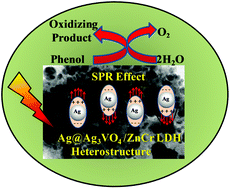当前位置:
X-MOL 学术
›
Inorg. Chem. Front.
›
论文详情
Our official English website, www.x-mol.net, welcomes your feedback! (Note: you will need to create a separate account there.)
Synergistic effects of plasmon induced Ag@Ag3VO4/ZnCr LDH ternary heterostructures towards visible light responsive O2 evolution and phenol oxidation reactions†
Inorganic Chemistry Frontiers ( IF 7 ) Pub Date : 2018-02-26 00:00:00 , DOI: 10.1039/c7qi00742f Dipti Prava Sahoo 1, 2, 3, 4 , Sulagna Patnaik 1, 2, 3, 4 , Dharitri Rath 1, 2, 3, 4 , K. M. Parida 1, 2, 3, 4
Inorganic Chemistry Frontiers ( IF 7 ) Pub Date : 2018-02-26 00:00:00 , DOI: 10.1039/c7qi00742f Dipti Prava Sahoo 1, 2, 3, 4 , Sulagna Patnaik 1, 2, 3, 4 , Dharitri Rath 1, 2, 3, 4 , K. M. Parida 1, 2, 3, 4
Affiliation

|
For enhancing solar energy conversion and environmental remediation, noble metal plasmonic photocatalysis originating from the effectual light absorbance and confinement of surface plasmons provides a new promising route. In the present study, by integrating these two aspects, a series of ternary Ag@Ag3VO4/ZnCr LDH heterostructures have been prepared by an in situ hydrothermal followed by co-precipitation method. In this method, there is self-assembling of Ag3VO4 nanoparticles on the brucite surface of the LDH material along with partial reduction of Ag+ to Ag. The phase identity, optical response, and morphological structure of the heterostructure photocatalysts were systematically characterized through PXRD, HRTEM, UV-Vis DRS, PL, and XPS methods. The resulting monodisperse Ag nanoparticles deposited on LDH materials offer a heterogeneous interaction at the interface and exhibit high photocatalytic activity towards generation of O2 and oxidation of phenol. Evaluation of photocatalytic activity showed that 40 wt% of Ag3VO4 modified LDH is the most effective photocatalyst for O2 evolution (571 μmol) and phenol oxidation (93%). The highly improved photocatalytic performance of the composite was ascribed mainly to the SPR effect of Ag nanoparticles, Schottky barriers formed at the interface of LDH and Ag3VO4 nanoparticles, and strong coupling between Ag, Ag3VO4 and LDH. The electrochemical studies such as LSV, CV, EIS and Tafel plots further support the high rate of photoactivity towards O2 evolution and phenol oxidation. These newly designed plasmonic Ag–LDH nanoheterostructures may offer a promising strategy for maximum light absorption and be authoritative in meeting environmental claims in the future.
中文翻译:

等离子体激元诱导的Ag @ Ag 3 VO 4 / ZnCr LDH三元异质结构对可见光响应O 2演化和酚氧化反应的协同作用†
为了增强太阳能的转化和环境修复,源自有效的光吸收和表面等离子体激元限制的贵金属等离子体激元光催化提供了一条新的有前途的途径。在本研究中,通过结合这两个方面,通过原位水热然后共沉淀法制备了一系列三元Ag @ Ag 3 VO 4 / ZnCr LDH异质结构。在这种方法中,在LDH材料的水镁石表面上存在Ag 3 VO 4纳米粒子的自组装,以及Ag +的部分还原。对银。通过PXRD,HRTEM,UV-Vis DRS,PL和XPS方法系统地表征了异质结构光催化剂的相身份,光学响应和形态结构。沉积在LDH材料上的所得单分散Ag纳米颗粒在界面处提供了异质相互作用,并且对O 2的生成和苯酚的氧化表现出高的光催化活性。光催化活性的评估表明,40 wt%的Ag 3 VO 4修饰的LDH是最有效的O 2光催化剂。析出(571μmol)和苯酚氧化(93%)。复合材料的高光催化性能主要归因于Ag纳米颗粒的SPR效应,LDH与Ag 3 VO 4纳米颗粒的界面处形成的肖特基势垒以及Ag,Ag 3 VO 4和LDH之间的强耦合。电化学研究(例如LSV,CV,EIS和Tafel图)进一步支持了高活性的光活性,可促进O 2析出和苯酚氧化。这些新设计的等离激元Ag-LDH纳米异质结构可能为最大的光吸收提供有前途的策略,并且在将来满足环境要求方面具有权威性。
更新日期:2018-02-26
中文翻译:

等离子体激元诱导的Ag @ Ag 3 VO 4 / ZnCr LDH三元异质结构对可见光响应O 2演化和酚氧化反应的协同作用†
为了增强太阳能的转化和环境修复,源自有效的光吸收和表面等离子体激元限制的贵金属等离子体激元光催化提供了一条新的有前途的途径。在本研究中,通过结合这两个方面,通过原位水热然后共沉淀法制备了一系列三元Ag @ Ag 3 VO 4 / ZnCr LDH异质结构。在这种方法中,在LDH材料的水镁石表面上存在Ag 3 VO 4纳米粒子的自组装,以及Ag +的部分还原。对银。通过PXRD,HRTEM,UV-Vis DRS,PL和XPS方法系统地表征了异质结构光催化剂的相身份,光学响应和形态结构。沉积在LDH材料上的所得单分散Ag纳米颗粒在界面处提供了异质相互作用,并且对O 2的生成和苯酚的氧化表现出高的光催化活性。光催化活性的评估表明,40 wt%的Ag 3 VO 4修饰的LDH是最有效的O 2光催化剂。析出(571μmol)和苯酚氧化(93%)。复合材料的高光催化性能主要归因于Ag纳米颗粒的SPR效应,LDH与Ag 3 VO 4纳米颗粒的界面处形成的肖特基势垒以及Ag,Ag 3 VO 4和LDH之间的强耦合。电化学研究(例如LSV,CV,EIS和Tafel图)进一步支持了高活性的光活性,可促进O 2析出和苯酚氧化。这些新设计的等离激元Ag-LDH纳米异质结构可能为最大的光吸收提供有前途的策略,并且在将来满足环境要求方面具有权威性。



























 京公网安备 11010802027423号
京公网安备 11010802027423号